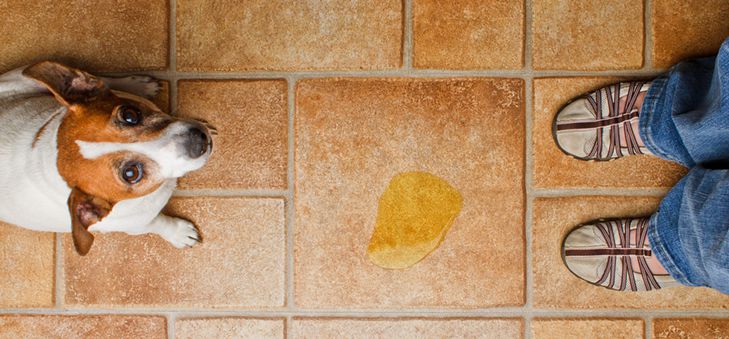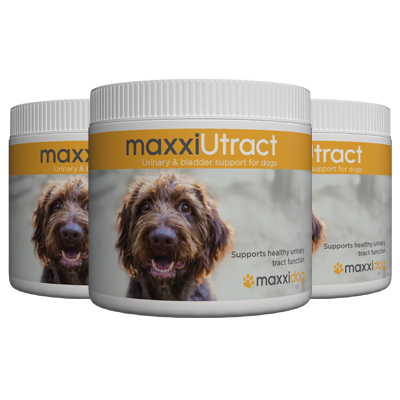Urinary Incontinence in Dogs
Urinary incontinence in dogs can be annoying for both the dog and the owner. Fortunetly there are things that can be done to support the bladder function and treat the condition

What is Urinary Incontinence in Dogs and What Can You Do About It?
Urinary incontinence is defined as the involuntary passage of urine, often recognised as urine leakage when lying down, and can be as much as a problem for you as an owner as it is for your dog. It is relatively common especially in neutered bitches, although there are cases of entire bitches and male dogs being affected. Urinary incontinence is most commonly an acquired condition developing at a later age, but occasionally it can present as a congenital disorder due to abnormal anatomical structures within the urinary tract.

What Are The Most Common Causes for Urinary Incontinence in Dogs?
Approximately 80% of cases of urinary incontinence are cause by a condition known as urinary sphincter mechanism incompetence (USMI). This can be a congenital or acquired condition and can affect both sexes, although is probably more recognised in bitches. There are several factors that contribute to USMI including both structural or functional abnormalities. These consist of reduced urethra tone, a shorter urethral length, abnormal bladder position (those located within the pelvis), larger dog breeds, spaying (surgical removal or the reproductive tract), hormones and obesity.
The association between spaying and urinary incontinence has been widely investigated. It is speculated to be caused by reduced circulating oestrogens thus the hormonal influences are suspected to be a factor. There is currently a lack of conclusive evidence as to whether spaying before their first season increases risk of incontinence later in life (>10 years) and remains a debate in the veterinary profession. Obesity, albeit not a direct cause, can also worsen the degree of incontinence most likely due to increased abdominal pressure on the bladder.
Treatment and Management for Urinary Incontinence in Dogs
Medical treatment consists of firstly ruling out a urinary tract infection if present. Your vet can determine this from a urine sample which is often sent off for culture and sensitivity testing at an external laboratory to confirm eradication. Further investigations can confirm whether there is a systemic condition such as diabetes or Cushing disease present which may exacerbate or precipitate incontinence, particularly if your pet is drinking and urinating more than usual.
On veterinary recommendation its might be suggested to put your pet on a weight loss diet if they are obese to help reduce urine leakage. If above issues are addressed then your veterinarian may prescribe medication to increase urethral tone.
Commonly used veterinary authorised drugs are listed in the table below:
Oestriol (Incurin, Intervet)
Short acting oestrogen licensed to treat urinary incontinence in bitches. Often used first line as relatively inexpensive and infrequently administered. Lower risk of adverse side effects though can cause bone marrow suppression in some cases which requires ongoing monitoring and potentially blood tests. Comes in tablet formulation.
Phenylpropopanolamine (Propalin, Vetoquinol)
Used to increase urethral outflow resistance. Acts directly on smooth muscle to increase urethral tone and maximal urethral closure pressure. Conveniently packaged and easy to administer liquid formulation.
Testosterone (Durateston, Intervet)
Injectable solution used in male dogs, though generally less effective than oestrogen therapy prescribed for female dogs.
If your dog has a structural abnormality present such as ectopic ureters surgical correction is most commonly indicated to correct the position to avoid urine leakage by allow urine to drain into the bladder rather than at the entrance to the bladder (bladder neck) and urethra. If your dog is affected by bladder stones then further imaging may be indicated, most commonly x-rays or contrast radiographs to outline radiolucent stones in the urinary tract.
Once confirmed surgical intervention may be required to remove the stones or alternatively a dissolution diet may be indicated to dissolve the stones depending on the type present. Alternatively if radiographs confirm that the bladder neck is located within the pelvis (termed intrapelvic bladder neck) then this may need to be relocated surgically to anchor it in the normal abdominal position.
Caring for your dog’s vital needs
We have all been there, stopping every few minutes and waiting patiently while our dog goes on with the important business of “pee-mailing”. Sometimes we get impatient, but never did we imagine that the day might come that we would miss this ritual. A urinary tract infection (UTI) makes urination painful for our dogs and you want to do everything you can to prevent your dog getting it. maxxiUtract can help you with exactly that.

Benefits
- Specifically designed to care for your dog’s urinary, kidney and bladder health
- Naturally nurtures and cares for the whole of your dog’s urinary system
- Can help to prevent painful urinary tract infection, UTI recurrence and aid recovery
"My old girl has been having lots of accidents around the house. She seems to be feeling better and has not had any accidents since starting using this. Very happy customer!"
References:
(1) BSAVA manual of nephrology and urology
(2) MSD MANUAL Veterinary Manual
(3) PETMD

